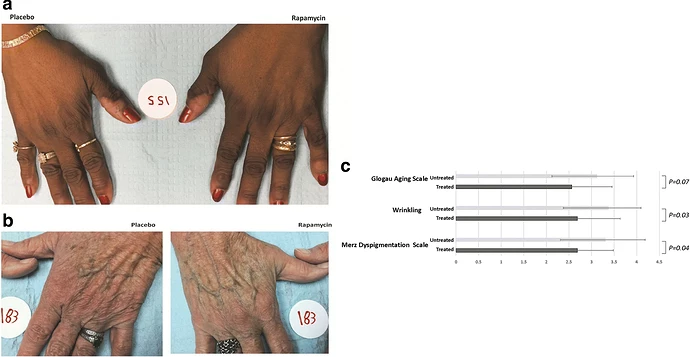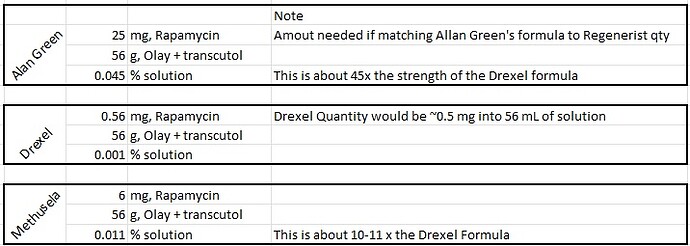$329 for 45g of 1%? That’s 450 mg of rapamycin in the single 45 gram tube/jar(!!!) Wow.
So far, in my limited experience with compounding pharmacies I have found that they are very expensive.
I’ve been making a serum I really like:
5mg rapamycin crushed and filtered
5 grams transcutol (suggested use at 1-10%)
70 grams hyaluronic/water mix
- hyaluronic powder suggested use .01-1%; 5 grams hyaluronic powder in 65 grams distilled water
(.005g rapa/75g transcutol-water-hyaluronic acid)= 0.0000666 = .00666% rapa serum
Hyaluronic acid powder and Transcutol from Lotion Crafter
Then I mix a bit of that potion with OneSkin facial supplement and apply twice a day. Still early days, but it does seem to be fading my sun damage.
Can someone explain why the cream or spray is necessary if you are taking rapa orally? Shouldn’t it affect your skin? Also, are you aware of any documentary photographs of people’s experience using Rapamycin topically? And are people using it on the face? Thank you
I would guess it gets into the dermis at much higher rates if its topically applied. I used it on my face and hands for 6 months - its OK. I’m not overwhelmed by its results.
Here are the photos and research:
The research study that suggests that rapamycin can be helpful for aging skin:
What would be interesting is if you could use your formulation only on one part of your body (e.g. one hand) and compare to the other hand after 3 months or 6 months, etc.
Great to see your DIY efforts! Love the creativity. I’m thinking of doing something similar with Dasatinib, transcutol, etc.
I’m not being very scientific about evaluating the results, I’m afraid. I thought about having a control area, but most of the sun damage and fine lines are on my face/neck/chest so I didn’t want to do just half in case it really does make a dramatic difference! Maybe I will add just one hand in, though. ![]()
Another approach is simply a photo now and in the future, try to get the exact same angle, lighting and distance… and compare every 3 or 4 months…
And always keep in mind…
“It has been reported that approximately 80% of skin aging on the face can be attributed to ultraviolet (UV) exposure [5]. Therefore, despite the emphasis of the market on the reversal of skin aging, the best defense against cutaneous age-related changes is through prevention with rigorous photoprotection [4]. It should be noted that proper photoprotection consists of seeking shade when outdoors; wearing a wide-brimmed hat, photoprotective clothing, and sunglasses; and applying sun protection factor (SPF) ≥ 30 broad-spectrum tinted sunscreen on exposed sites.”
Absolutely, if you are a sun worshipper you will pay the price with photoaged skin or worse.
Better just to take a vitamin D supplement and stay out of the sun as much as possible if you want your skin to age slowly.
There is some exciting/fascinating new research involving health benefits of near-infrared and infrared light, which bypasses sunscreen, penetrates clothing and may account for some of the benefits of spending time outdoors. In short, infrared light regenerates intracellular melatonin which protects mitochondria. Staying indoors and popping vitamin D supplements may not be enough:
Thanks for the suggestion Mike. I’ll look into it and may want to try it down the line.
I’ve been on a two month washout and have also skipped the knee applications. Pain itself never was a big problem, more of a warning sign - kept me from doing squats and the like, so I forgot all about the knees until you brought up the subject.
Just now did some butt-all-the way-to-the-floor deep knee bends and there’s not much pain at all. The rapamycin in aloe gel with dmso may have been working.
I’m starting back on my regular routine of twelve mg with grapefruit juice once every two weeks. For now, I’m going to skip the knees and keep watch to see if there may have been some long-term improvement.
I like the idea of mixing rapamycin with OneSkin. I still use both separately. If I had to choose one, I would pick OneSkin but I tend to like the option of both with one application.
Which hyaluronic powder did you use? they have many… Also you mix with OneSkin on your hand?
Thanks!
desertshores, Since your use of the 10 mg to 12 mg rapamycin in 100 grams (transcutol + water) showed nothing at the ~3 month time, did you increase the amount of rapamycin in your solution? If so, have you seen any results? Thanks.
It may be working but the effects are subtle. I was already having very good results from Tretinoin(Retinal A) 0.5 %. I don’t plan on changing anything at this time.
I’m about to make my first batch using this method and dug into the numbers a bit more. I wanted to compare the Drexel formula to Alan Green and Methusela’s formulas.
To start, I calculated the total mass of rapamycin needed for a 56 ml solution of the Olay Regenerist (50 ml) with an extra ~6 ml of transcutol for dissolving the rapamycin ala Methusela, using the 10 micromolar number they gave in the paper:
This shows that you need about 0.5 mg to reach the same molarity in a 56 ml solution. I tried to show the formulas I used in the bottom row. Please correct me if I’m wrong on any of this.
Then, I compared the formulas of Dr. Green and Methusela:
Here we see that Dr. Green’s formula is much stronger (45x) the strength of the Drexel formula. Here, I used % solution because that is what Dr. Green references and it’s also easier. All these calculations assume that the density of the liquid is the same as water (1 g/cc), which I think is reasonable. Dr. Green uses Aquaphor, and I couldn’t find an exact number for that, but I think 1 g/cc is still reasonable. Notice that Methusela’s formula is about 10x the Drexel formula. I think I will use something closer to that since Methusela has had good results.
For fun, I also calculated the amount of rapamycin used in the OneSkin paper, where OneSkin touts superior results compared to rapamycin cream. They had a 100 nM solution (paper linked at end):
That means you would mix 0.005 milligrams into a 56 ml solution, which is minuscule! I find the claims that OneSkin is better than rapamycin to be disingenuous, since it’s 100x weaker than even the Drexel formula.
Here’s the paper:
Rad, this is an excellent contrast. I defer to AG and Drexel for their reasoned methodology in the formulation. My concoction is a guess, as I surmise is theirs. I’m happy with my results.
Great analysis and summary! Thanks so much for posting.
The comparison to the Oneskin product is really helpful.
Dr. Green actually recommends 3 MG rather than 45 MG. He uses a higher % because of sun damage to his scalp. He prescribed me eight pills (24 MG) to use over the next 12-18 months to make my own do it yourself skin cream. As far as OneSkin to rapamycin, I tested both, one on each arm. OneSkin was hands down the winner in my n=1 experiment. Now I use both.




